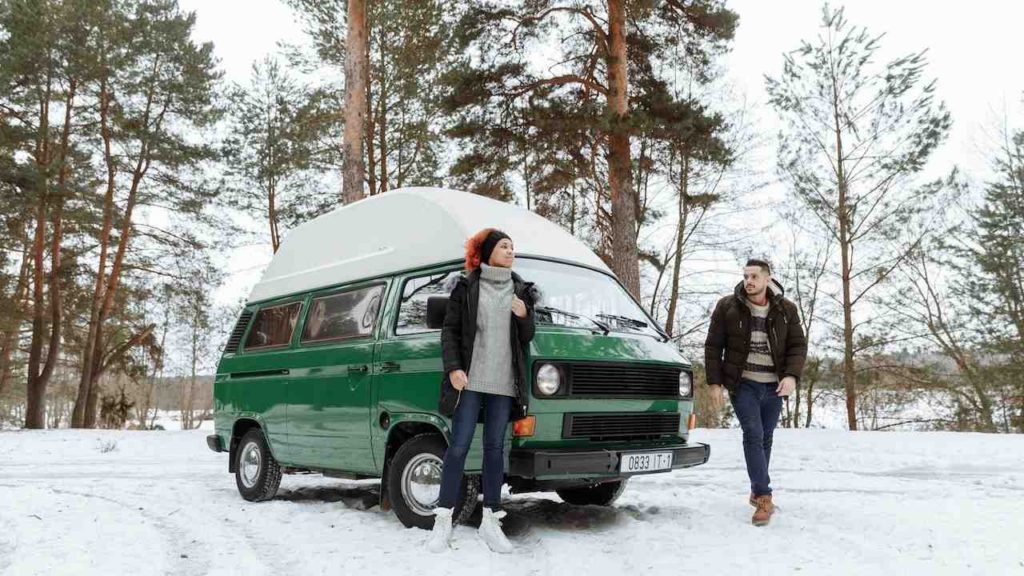
Camping in the late autumn, or–dare I say it–in the winter is such a daunting proposition to many people. They worry about freezing, but if you wear the right gear, then that’s not going to happen. What do you wear when camping in the cold?
When camping in the cold, most importantly, you must dress in layers. That means wearing a base layer, a middle layer, and an outer layer. You also need thick socks, mittens or gloves, a winter hat, and winter boots.
Don’t worry; if you’re not quite clear on everything yet, I’ll explain to you exactly what you should wear when camping ahead. You’ll find that despite the undeniable chill in the air you won’t feel it quite as much!
The Most Important Part About Dressing for the Cold – Layering Up
I can’t stress enough that the most critical part of staying warm in the cold is wearing more than one layer. Ideally, you need three layers.
To reiterate from the intro, those are the base layer, the middle layer, and the outer layer.
Now, I’ve touched on what should comprise each of these layers in other posts on the blog, especially lately in my posts on seasonal camping.
In this section, I want to go ultra-in-depth, so you have no question in your mind about how to dress.
Base Layer
Let’s start with the base layer, which is the first of the three layers you’ll wear and the one that is the closest to your body.
The base layer consists of long underwear (worn like leggings), underwear crew shirts, and the like.
Even if you’re not the type who usually wears tight clothing, your base layer should still be tighter than the rest of your wardrobe. It doesn’t have to be skin-tight, mind you, but close.
After all, the base layer is supposed to trap in heat and wick away moisture, and it can’t do either very well if it’s not up against your skin.
You can choose from three base layer weights. If you’ll be camping in cool but not freezing cold temperatures, then a lightweight base layer is fine.
If the temperatures will be a lot colder, then a midweight base layer suffices.
Should you brave below-freezing temperatures, then only a heavyweight base layer would do.
You can select from a multitude of base layer materials, but only some are suitable. They are as follows:
- Wool with embedded ceramic particles for pulling in and then dissipating body heat
- Silk for odor resistance, softness, and some moisture wicking
- Merino wool for odor resistance, durability, thermoregulation, and moisture wicking
- Synthetics for odor resistance, durability, and fast-drying properties
Middle Layer
The middle layer also has another name, the insulating layer.
As that name implies, the middle layer is designed to retain more of your body heat that’s created by the base layer.
Your body will trap in this heat so that you don’t feel nearly as cold as the outdoor temperatures would suggest.
The insulating layer includes mostly jackets, from down hoodies to insulated hoodies to insulated jackets.
Don’t worry, there’s still a third layer to your cold-weather uniform, so it’s okay if the middle layer is thin. You’re not going out in just your base layer and the middle layer.
The middle layer is available in different thicknesses, but there’s not too much disparity between them. The same differences in thickness as for the base layer apply.
There does exist a greater disparity between material choices, so let’s cover your options now.
- Polyester fleece: Polyester fleece is available in three thicknesses: 100 weight (lightweight), 200 weight (midweight), and 300 weight (heavyweight). Wind travels through fleece easily but it doesn’t lose its warmth even when damp. Fleece is also breathable and fast-drying.
- Synthetics: A synthetic insulated jacket is bulkier than down but retains heat well. The level of wind and water resistance is also excellent.
- Down: A down insulated jacket has a varying level of fill power, anywhere from 450 through 900. The greater the fill power, the warmer your jacket. Down cannot get wet or it won’t work as well.
Outer Layer
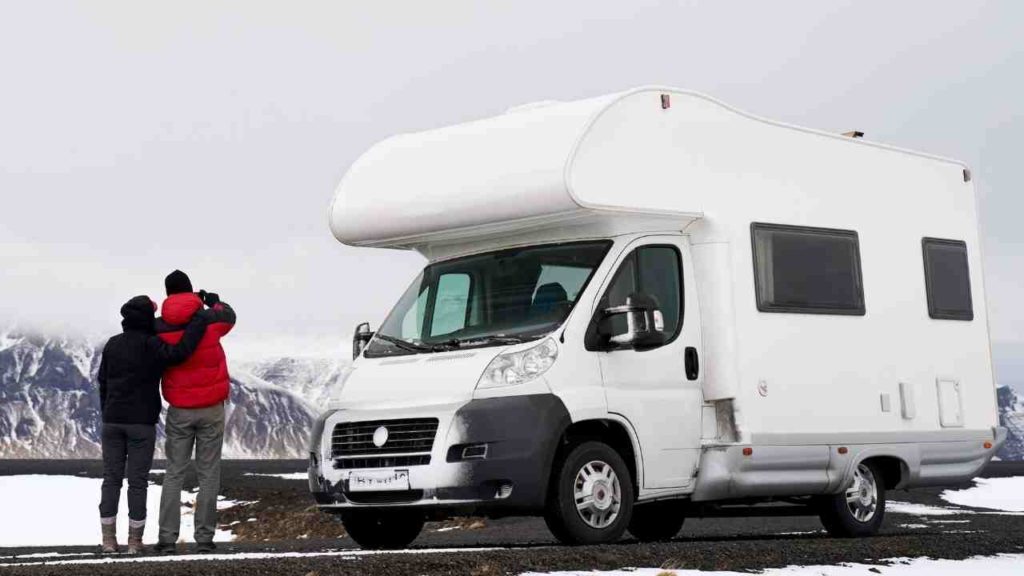
The third and final layer of the three is the outer layer, which some refer to as a shell layer.
The shell layer adds further to your body heat while also protecting you against the wind, rain, sleet, and snow.
Your outer layer will include snow pants and a jacket or coat. These layers must be both windproof and waterproof. Water resistance is not good enough in this case.
When clothing is water-resistant, it means that it comes with a coating that allows the water to slough off your jacket or pants. Over time, the coating fades.
Waterproof garments are sewn that way and never lose their waterproofing.
Just as your outer layer can be either water-resistant or waterproof, it can be wind-resistant or windproof.
Wind resistance is most common in water-resistant materials. You get some degree of wind protection, but not nearly as much as you do compared to a windproof outer layer.
If your shell layer is waterproof, then it will be windproof as well. How windproof the layer will be varies based on the manufacturer. For example, REI jackets are windproof up to 60 miles per hour.
The types of shells that are available are different as well, so let’s go over the various types now.
- Insulated shell: The most highly recommended for your cold-weather camping excursions, an insulated shell has synthetic or down fill. These shells are still very breathable and at least water-resistant. If your insulated shell has seam sealing, then it’s waterproof.
- Hybrid shell: A hybrid shell includes both hard and soft shell components and is usually quite windproof and waterproof, especially in the more rigid areas. Other parts of the jacket might be softer and more flexible such as underneath the sleeves, on the back, or on the sides. These areas are very breathable as well.
- Soft shell: A soft outer shell features water resistance and insulation all in one. Some soft shells are only intended to be worn as the outer layer and others can be a middle layer and an outer layer in one. Soft shells are ultra-breathable but less cold, wind, and rain-protective.
- Hard shell: The opposite of a soft shell, a hard outer shell is stiff but very breathable and waterproof. However, you get no insulation, so you’ll need an especially good middle layer to avoid shivering and shaking.
Choosing Socks and Shoes for Cold Weather Camping
You’ve got your long underwear and snow pants as well as your insulating jacket but nothing on your feet.
Let’s next go over what to wear on your feet even if you’re crunching through several feet of snow.
Socks
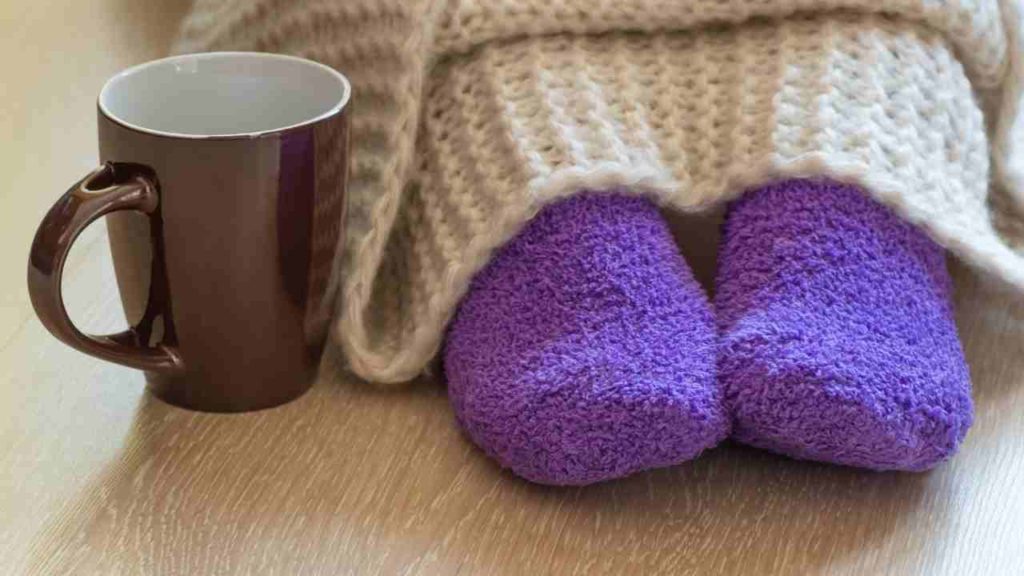
Camping socks come in so many materials, how do you choose?
Cotton is about the worst sock material you can wear. I bet that 90 percent if not 100 percent of your socks are all made of cotton, but that just won’t work when camping in the late autumn or winter. Your feet will freeze.
Here’s why.
Cotton absorbs sweat. It also takes forever for cotton to dry.
In warmer weather, this is how you end up with blisters, especially when embarking on a long, arduous hike.
In the winter, the results of wearing cotton socks are even more detrimental still.
Your socks will become wet with sweat, which will start off as warm and become very cold. Since your socks won’t dry, you’ll be walking around with wet, cold socks with every step you take.
If that sounds excruciating in the cold, that’s because it is.
Here are some materials for you to consider instead:
- Silk, which feels great, doesn’t weigh much, and wicks away moisture
- Ingeo, a type of polylactic acid material that’s sourced from corn; it’s great for odor resistance and moisture wicking but is not very durable
- Synthetics like Lyrca and nylon, which have great cushioning, moisture wicking, fast-drying properties, and durability
- Merino wool, which is soft and cushioning, odor-resistant, and moisture wicking
Should you automatically buy the thickest socks? No!
How thick your winter socks should be depends on the thickness of your boots.
If your boots have a very close fit to your feet, then wearing very thick socks will make it hard to stuff your foot into the boot.
Worse yet, the boot will rub against your feet, which creates friction that can lead to painful blisters.
If your socks are too thin, then your feet might have too much room in your boots. That too is detrimental to your boot fit.
Shoes
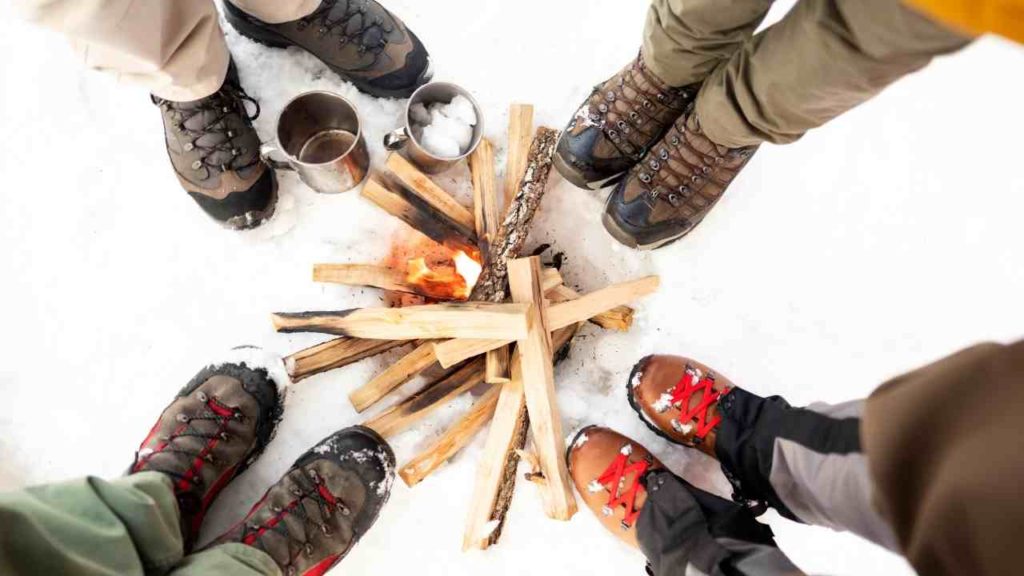
Speaking of boots, they’re another major consideration as you plan your cold-weather camping trip.
If you already own hiking boots, then the good news is that you can wear them if the area you’ll be camping in is only somewhat snowy.
I’m talking several inches of snow on the ground with no weather predictions for more snow.
Once you get into deeper snow, then you’ll need mountaineering boots. Allow me to take the rest of this section to discuss mountaineering boots and how to pick them.
First, know that you don’t necessarily have to buy mountaineering boots, especially if you aren’t 100 percent sure that you will camp again in the cold. You can always rent a pair of boots instead.
That does mean that you have to take better care of them than you would boots that you own, as you’re expected to return the boots in excellent condition.
Three-season boots are one type of mountaineer boots to consider. These boots aren’t very comfortable until you break them in, but then they fit you like a glove.
Lightweight, waterproof, and abrasion-resistant, three-season boots don’t overheat if you wear them in warm weather.
Insulated boots feature several layers of construction that make them the better choice for camping in the cold. These boots also need time to break in. They’re waterproof and rugged too.
Please don’t wait until you go camping to break in your mountaineering boots. Take time in the weeks ahead to gradually break the boots in.
To do that, wear them around the house, when at work or school, and when you’re out and about (except not at places like the gym, obviously).
It can take days to weeks depending on the boots and how often you wear them, but you will break them in.
You’ll know that your mountaineering boots are broken in if wearing them no longer produces pain or discomfort.
By now, you’re probably sold on winter camping, but if you’re not, find out why winter is the best time of year to camp.
Other Winter Essentials You Need for Camping
You’ve got your cold-weather camping clothing basics by now, but you can and should continue to stock up on gear. Here’s what else you need.
Glasses or Goggles
It doesn’t always occur to campers to wear glasses or goggles until they’re out on a hike wishing they had a pair of sunglasses.
Don’t wait until it’s too late to safeguard your eyes. A pair of glasses or goggles protects from more than the sun, after all, but the painful effects of wind as well.
Glasses and goggles will have a visible light transmission or VLT rate. Depending on what kinds of conditions you’ll be camping in, the VLT rate you need varies.
For instance, if the days will be sunny, bright, and cold, then a VLT between zero and 19 percent suffices. The glasses or goggles should have dark lenses as well.
In overcast weather, the VLT should be higher still, between 20 and 40 percent. There’s no need for dark-colored lenses, though. Rather, the lenses should be rose, amber, gold, or yellow.
These hues will add more contrast in conditions where the light is flat.
Mittens and Gloves
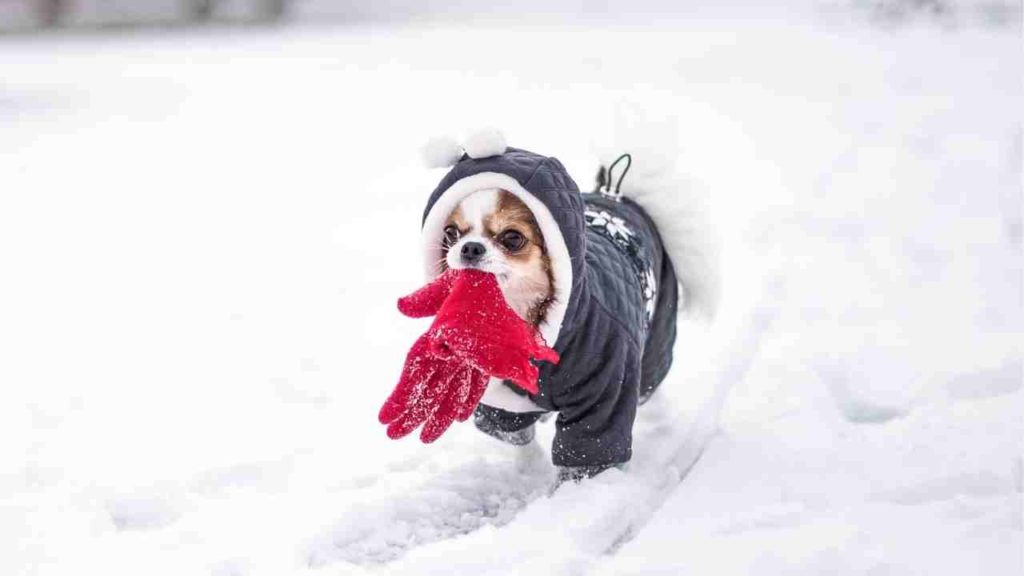
Mittens are usually woven and thicker than gloves (although obviously, that depends very much on the type of glove we’re talking about), and thus, it’s good to have a pair in your backpack.
The gloves will warm up your fingers but at the expense of dexterity.
I wouldn’t advise you to wear mittens when hiking, fishing, trying to start a fire, or when engaging in any other activity that requires hand dexterity.
Gloves, even if they’re cotton, will keep your fingers warm. However, you should know by now that cotton is the enemy when trying to stay warm.
You’re much better off with a pair of fleece gloves. Even better, invest in some insulated gloves with a breathable and waterproof shell. You won’t regret it!
Winter Hat
Last but certainly not least, you should wear a winter hat.
Winter hats come in all sorts of styles. If you want only some protection, then a beanie made of synthetics or merino wool is sure to keep your noggin warm.
Make sure that when the beanie is on your head, it stays over your ears. If your ears are exposed, then you’re going to get cold very quickly!
If the beanie just isn’t cutting it because it’s that cold out, then you can always upgrade to a balaclava or a face mask.
You perhaps don’t get as much visibility or maneuverability in these garments, but they will protect way more than your ears. The rest of your face will be warmer as well.
Conclusion
Although the list of what you should wear when camping in the cold isn’t long, each item is very important and thus cannot be skipped or alternated with something else.
I want to again stress how critical it is to layer up. When you follow those dressing rules for layers, you’ll find that even in very cold temperatures where your teeth would otherwise be chattering that you feel alright!
